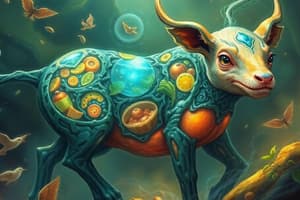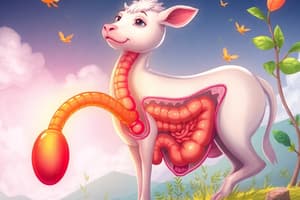Podcast
Questions and Answers
Which dietary category includes animals that consume both plants and animals?
Which dietary category includes animals that consume both plants and animals?
- Herbivores
- Detritivores
- Omnivores (correct)
- Carnivores
What is the primary purpose of biosynthesis in animals?
What is the primary purpose of biosynthesis in animals?
- To eliminate undigested material
- To absorb essential nutrients from the diet
- To break down food into smaller molecules
- To synthesize new molecules required for growth and function (correct)
Which of the following stages of food processing involves the breakdown of food into small molecules?
Which of the following stages of food processing involves the breakdown of food into small molecules?
- Ingestion
- Absorption
- Elimination
- Digestion (correct)
In which type of digestion do animals avoid self-digestion by processing food inside specific compartments?
In which type of digestion do animals avoid self-digestion by processing food inside specific compartments?
Which of the following organisms primarily utilizes a gastrovascular cavity for digestion?
Which of the following organisms primarily utilizes a gastrovascular cavity for digestion?
What process involves the uptake of food into cells for digestion?
What process involves the uptake of food into cells for digestion?
Which group of animals primarily utilizes intracellular digestion?
Which group of animals primarily utilizes intracellular digestion?
What is a characteristic of a complete digestive system?
What is a characteristic of a complete digestive system?
What are the two main functions of a gastrovascular cavity?
What are the two main functions of a gastrovascular cavity?
How does food movement differ between incomplete and complete digestive systems?
How does food movement differ between incomplete and complete digestive systems?
What happens to the glottis during the process of swallowing?
What happens to the glottis during the process of swallowing?
Which structure closes to prevent food from entering the trachea?
Which structure closes to prevent food from entering the trachea?
What is the main function of the esophageal sphincter after food enters the esophagus?
What is the main function of the esophageal sphincter after food enters the esophagus?
What is the primary action of the larynx during swallowing?
What is the primary action of the larynx during swallowing?
Which statement describes the sequence of events that occurs after a bolus of food is swallowed?
Which statement describes the sequence of events that occurs after a bolus of food is swallowed?
What hormone secreted by the duodenum stimulates the pancreas to release sodium bicarbonate?
What hormone secreted by the duodenum stimulates the pancreas to release sodium bicarbonate?
Which structure is primarily responsible for nutrient absorption in the small intestine?
Which structure is primarily responsible for nutrient absorption in the small intestine?
What is the primary role of the large intestine?
What is the primary role of the large intestine?
Which of the following components of the colon is involved in the production of vitamins?
Which of the following components of the colon is involved in the production of vitamins?
What is the inactive form of pepsin known as?
What is the inactive form of pepsin known as?
How long is the colon typically in an adult human?
How long is the colon typically in an adult human?
What is the function of the lacteals found in the small intestine?
What is the function of the lacteals found in the small intestine?
What unique feature of the large intestine helps in the formation of feces?
What unique feature of the large intestine helps in the formation of feces?
What is the primary function of salivary amylase in the oral cavity?
What is the primary function of salivary amylase in the oral cavity?
Which process primarily moves food from the esophagus to the stomach?
Which process primarily moves food from the esophagus to the stomach?
What prevents the food from entering the trachea when swallowing?
What prevents the food from entering the trachea when swallowing?
What is the role of bile salts in fat digestion?
What is the role of bile salts in fat digestion?
Which enzyme is responsible for protein digestion in the stomach?
Which enzyme is responsible for protein digestion in the stomach?
What are the products of carbohydrate digestion in the small intestine?
What are the products of carbohydrate digestion in the small intestine?
What is the time taken for food to pass through the stomach?
What is the time taken for food to pass through the stomach?
Where does the majority of nutrient absorption occur in the digestive system?
Where does the majority of nutrient absorption occur in the digestive system?
Which of the following enzymes cleaves bonds adjacent to certain amino acids in protein digestion?
Which of the following enzymes cleaves bonds adjacent to certain amino acids in protein digestion?
What forms the bolus in the oral cavity?
What forms the bolus in the oral cavity?
Which digestive phase involves enzymes breaking down food in the small intestine?
Which digestive phase involves enzymes breaking down food in the small intestine?
What is the main function of the rectum in the digestive system?
What is the main function of the rectum in the digestive system?
What role do dipeptidases play in digestion?
What role do dipeptidases play in digestion?
The time food takes to pass through the large intestine is approximately?
The time food takes to pass through the large intestine is approximately?
What occurs in the esophagus when a person is not swallowing?
What occurs in the esophagus when a person is not swallowing?
What happens to the epiglottis during the swallowing reflex?
What happens to the epiglottis during the swallowing reflex?
Which enzyme is specifically involved in carbohydrate digestion in the mouth?
Which enzyme is specifically involved in carbohydrate digestion in the mouth?
What is the primary role of bile salts in the digestion of fats?
What is the primary role of bile salts in the digestion of fats?
What type of digestion is primarily facilitated by enzymes in the small intestine?
What type of digestion is primarily facilitated by enzymes in the small intestine?
How are smaller polypeptides handled after being formed in the stomach?
How are smaller polypeptides handled after being formed in the stomach?
What is the final product of lipid digestion by pancreatic lipase?
What is the final product of lipid digestion by pancreatic lipase?
Which is the inactive form of the enzyme responsible for protein digestion in the stomach?
Which is the inactive form of the enzyme responsible for protein digestion in the stomach?
What role do disaccharidases play in the small intestine?
What role do disaccharidases play in the small intestine?
During which phase of digestion does the gastric sphincter control the movement of food?
During which phase of digestion does the gastric sphincter control the movement of food?
What triggers the esophageal sphincter to relax as food moves from the esophagus to the stomach?
What triggers the esophageal sphincter to relax as food moves from the esophagus to the stomach?
Which part of the digestive system is primarily responsible for the breakdown of nucleic acids?
Which part of the digestive system is primarily responsible for the breakdown of nucleic acids?
Which type of saliva enzyme begins the digestion of starch?
Which type of saliva enzyme begins the digestion of starch?
What is the primary function of pancreatic trypsin during digestion?
What is the primary function of pancreatic trypsin during digestion?
Flashcards
Carnivores
Carnivores
Animals that obtain energy and nutrients by consuming other animals.
Herbivores
Herbivores
Animals that obtain energy and nutrients by consuming plants.
Omnivores
Omnivores
Animals that obtain energy and nutrients by consuming both plants and animals.
Digestion
Digestion
Signup and view all the flashcards
Intracellular Digestion
Intracellular Digestion
Signup and view all the flashcards
Gastrovascular Cavity
Gastrovascular Cavity
Signup and view all the flashcards
Complete Digestive Tract
Complete Digestive Tract
Signup and view all the flashcards
Incomplete Digestive Tract
Incomplete Digestive Tract
Signup and view all the flashcards
Epiglottis
Epiglottis
Signup and view all the flashcards
Glottis
Glottis
Signup and view all the flashcards
Esophagus
Esophagus
Signup and view all the flashcards
Esophageal Sphincter
Esophageal Sphincter
Signup and view all the flashcards
Swallowing
Swallowing
Signup and view all the flashcards
Cholecystokinin (CCK)
Cholecystokinin (CCK)
Signup and view all the flashcards
Secretin
Secretin
Signup and view all the flashcards
Villi
Villi
Signup and view all the flashcards
Microvilli
Microvilli
Signup and view all the flashcards
Lacteal
Lacteal
Signup and view all the flashcards
Large Intestine (Colon)
Large Intestine (Colon)
Signup and view all the flashcards
Appendix
Appendix
Signup and view all the flashcards
Esophageal sphincter muscle
Esophageal sphincter muscle
Signup and view all the flashcards
Swallowing reflex
Swallowing reflex
Signup and view all the flashcards
Peristalsis
Peristalsis
Signup and view all the flashcards
Salivary amylase
Salivary amylase
Signup and view all the flashcards
Pepsin
Pepsin
Signup and view all the flashcards
Pancreatic trypsin and chymotrypsin
Pancreatic trypsin and chymotrypsin
Signup and view all the flashcards
Pancreatic lipase
Pancreatic lipase
Signup and view all the flashcards
Disaccharidases
Disaccharidases
Signup and view all the flashcards
Dipeptidases
Dipeptidases
Signup and view all the flashcards
Alimentary Canal
Alimentary Canal
Signup and view all the flashcards
Initial Movement of Food
Initial Movement of Food
Signup and view all the flashcards
Bolus
Bolus
Signup and view all the flashcards
Protein Digestion in the Stomach
Protein Digestion in the Stomach
Signup and view all the flashcards
Nutrient Absorption
Nutrient Absorption
Signup and view all the flashcards
Waste Elimination
Waste Elimination
Signup and view all the flashcards
Study Notes
Animal Digestion
- Animal digestion involves three dietary categories: herbivores, carnivores, and omnivores.
- All animals require fuel for energy and biosynthesis (making new molecules).
- Animals also need essential nutrients (like amino acids, fatty acids, vitamins, and minerals) that cannot be synthesized by their bodies.
Stages of Food Processing
- Food processing involves four stages: ingestion, digestion, absorption, and elimination.
- Ingestion is the initial intake of food.
- Digestion breaks down complex food molecules to absorbable sizes.
- Absorption of nutrients occurs, transferring them into the body cells.
- Elimination is the expulsion of undigested material.
Types of Digestion
- Digestion can be intracellular (within cells, using vacuoles and lysosomes) or extracellular (outside cells in specific compartments like a gastrovascular cavity).
- Intracellular digestion is common in single-celled organisms and some animals.
- Extracellular digestion occurs in more complex animals which may have gastrovascular cavities.
Gastrovascular Cavity
- The gastrovascular cavity is a digestive compartment, found in some invertebrates (e.g., cnidarians)
- Digestion begins in the cavity with enzymes from the gastrodermis.
- Digestion is completed within cells of the lining, using intracellular processes.
Simple vs. Complex Digestive Systems
- Some animals (e.g., sponges and jellyfish) have a simple digestive system with one opening for both ingestion and elimination.
- Most animals have a complete digestive system (a tube with two openings: mouth and anus), allowing for specialized digestion compartments.
Human Digestive System Review Questions
- What are intracellular and extracellular digestion?
- What are the two functions of the gastrovascular cavity?
- What is the difference between a complete and an incomplete digestive system?
Alimentary Canal
- In the alimentary canal, food moves in one direction, facilitating specialized compartments for different digestive steps.
- The human alimentary canal includes the oral cavity, pharynx, esophagus, stomach, small intestine, and large intestine. Accessory organs like the liver, pancreas, and gallbladder play vital roles in digestion.
Enzymatic Digestion
- Digestion of carbohydrates, proteins, nucleic acids and fats occur by a variety of enzymes at different stages in the digestive tract. These enzymes break these complex molecules into their smaller components for absorption. Specific enzymes for each class of molecule are found at different locations, like the mouth, stomach or the small intestine. Examples include amylase and lipase.
- The epithelium of the small intestine has brush border enzymes to further digest the components.
Initial Movement of Food
- Food enters as a bolus in the mouth.
- Salivary amylase in saliva begins starch digestion.
- Food is moved to the stomach via peristalsis.
- Epiglottis covers/protects the airway during swallowing.
From Mouth to Stomach
- Mechanical and enzymatic actions and movements (peristalsis) move food to the stomach. The epiglottis protects the airway when swallowing.
Stomach
- Mechanical churning mixes food with gastric juices.
- Pepsinogen is activated by hydrochloric acid (HCl) to form pepsin, initiating protein digestion.
- Mucus protects the stomach lining from the acid.
- Chyme, a partially digested mixture, forms in the stomach and is emptied progressively into the small intestine.
Stomach in Detail
- The interior surface of the stomach wall is highly folded.
- Three types of cells in the gastric glands secrete components of gastric juice: mucus cells, chief cells, and parietal cells.
- Gastric juice contains hydrochloric acid (HCl), pepsinogen, and mucus.
- Pepsinogen is converted into pepsin by HCl, which activates more pepsinogen in a chain reaction.
- HCI converts pepsinogen into pepsin, resulting in protein digestion.
- Pepsinogen and HCI into the lumen of the stomach. HCI converts pepsinogen into pepsin. Pepsin then activates more pepsinogen, in a chain reaction.
Small Intestine in Detail
- Enzymes from the pancreas and liver, along with intestinal enzymes, complete digestion in the small intestine.
- The nutrients are absorbed into the blood or lymph.
Accessory Glands
- Pancreas produces enzymes (amylases, proteases, lipases, nucleases) that aid digestion. It also secretes bicarbonate to neutralize stomach acid.
- Liver produces bile that is stored in the gallbladder. Bile aids fat digestion by emulsifying fats. It also removes waste products.
Hormonal Control of Digestion
- Hormones like gastrin, secretin, and cholecystokinin regulate digestive processes through feedback loops, influencing various digestive organs and their secretions.
- Hormones like cholecystokinin and secretin regulate digestive processes.
Absorption of Nutrients in the Small Intestine
- The inner surface of the small intestine is highly folded and contains villi and microvilli which greatly increases surface area for absorption of nutrients into the blood or lymph. These folded structures are important for maximizing absorption rates.
Large Intestine
- The large intestine absorbs water and electrolytes. It houses gut microflora, which aid in vitamin synthesis. Produces faeces for expulsion.
- Appendix has a role in defense, and plays a role in immune function.
Microbiome and Gut Microflora
- The microbial community (microbiome) in the digestive tract includes bacteria, fungi, and viruses.
- These microbes participate in digestion, vitamin synthesis, and maintaining gut health.
- The microbiome plays an important role in digestion and health.
Revision
- Where does absorption of nutrients occur?
- Where does protein digestion commence?
- What food group does amylase break down?
- What is the inactive form of pepsin?
- What are three functions of the colon?
- What are three functions of the colon?
Cecum
- Most mammalian herbivores have a relatively large caecum.
- The caecum contains bacteria aiding in plant material breakdown (e.g. cellulose).
- In contrast, carnivores have decreased cecum size, often being replaced by an appendix.
Microbiome Research
- The human gut contains 500-1000 microbial species.
- Commensal bacteria in the gut can convert dietary fibre to short-chain fatty acids and vitamin K.
- Microbiome research examines the gut-brain axis impact on anxiety, obesity, and memory.
- Studies involve examining the effects of factors such as diet, antibiotics, probiotics and faecal transplants on the gut microbiome.
Studying That Suits You
Use AI to generate personalized quizzes and flashcards to suit your learning preferences.




